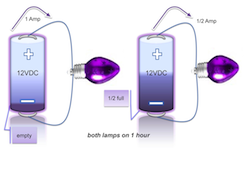Energy conservation (using less to do more) is healthy for the Earth and reduces a renewable-energy utility station’s size and cost. Obviously, more battery power will make a light bulb last longer, but it is less obvious that a more efficient light bulb requires less battery power. Typical electric circuits push electrons through an electrical conductor to reach the load before returning to the source.
Household circuits use 120V or 240V AC pressure (voltage) to do this. Battery-powered circuits use voltages set at 12V DC, 24V DC, or 48V DC, depending on load size and the required amount of electron flow (or current) for operation.For instance, a 12V supply with 1A current flow can light an ordinary bulb, but a light bulb running on 12V with 0.5A current can offer the same light intensity.
 This infers that the second bulb is twice as efficient as the first. In other words, with the more efficient bulb you would need a battery bank that is half the size to provide light for the same duration or a full-sized battery-bank to run the second bulb for twice as long, both at a lower operating cost.
This infers that the second bulb is twice as efficient as the first. In other words, with the more efficient bulb you would need a battery bank that is half the size to provide light for the same duration or a full-sized battery-bank to run the second bulb for twice as long, both at a lower operating cost.
Scientifically, there is a relationship between the pressure (voltage) and the current (amperage), which determines the amount of voltage needed to move the amount of electrons through the circuit for a load to operate. This is known as power and is measured in watts (W), used by the load. For the bulb example above, you can compare the 2 circuits’ power:
- An ordinary lamp: 12V x 1A = 12W
- A more efficient lamp: 12V x 0.5A = 6W
The more efficient lamp uses 50% less power. Now, recalling that logic dictates longer operation for a more efficient bulb using the same battery, is time a factor in the efficiency equation? Absolutely. Assuming that a battery consists of a fixed amount of electrons, which are used over time, it is fair to assume that the battery will eventually go flat (run out of power). Thus, the power or the electrons used over time is the electric energy .
Formula for Energy: power x time when the load is in use
- Ordinary Lamp:
12V x lA x 1 hour = 12 watt-hours (or 12W x 1 hour = 12 watt-hours)
- More Efficient Lamp:
12Vx 0.5A x 1 hour = 6 watt-hours (or 6W x 1 hour = 6 watt-hours)
As you can see from these calculations, your electricity supplier charges you for the energy you consume, not the power. Switching off any unused lights, so that the duration when the load is on is reduced, decreases your energy costs. Similar calculations are used to determine the energy stored in a battery bank. As an exercise, consider a 12V battery bank on 10A load running for 30 hours. What is the energy stored in the battery?
- Battery Bank Energy (in watt-hours):
12V x 10A x 30 hours = 3,600 watt-hours
(or 3.6 kilowatt-hours (kWh) of energy)
It is interesting to note that the battery voltage can ‘dip’ and ‘rise’ depending on the state of